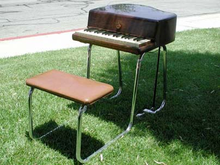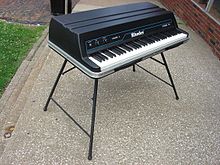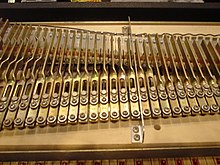Rhodes piano
| Rhodes piano | |
|---|---|
 A Rhodes Mark II | |
| Manufacturer | Harold Rhodes (1946–59) Fender Electric Instrument Company (1959–65) CBS (1965–83) William Schultz (1983–87) Roland Corporation (1987–91) Rhodes Music Corporation (1997–present) |
| Dates | 1946 ("Pre piano") 1959 (Piano bass) 1965 (MkI "suitcase") 1970 (MkI "Stage") 1979 (MkII) 1984 (Mk V) 1987 (Roland Rhodes MK 80) 2007 (Mark 7) |
| Technical specifications | |
| Polyphony | Full |
| Oscillator | Induced current from a pickup |
| Synthesis type | Electromechanical |
| Effects | Tremolo, stereo auto-pan |
| Input/output | |
| Keyboard | 73 or 88 keys |
| External control | Line out or DIN connector to external amp /mixing board Sustain pedal |
The Rhodes piano (also known as the Fender Rhodes piano or simply Fender Rhodes or Rhodes) is an electric piano invented by Harold Rhodes, which became particularly popular throughout the 1970s. Like a piano, it generates sound using keys and hammers, but instead of strings, the hammers strike thin metal tines, which are then amplified via an electromagnetic pickup which is plugged into an external keyboard amplifier and speaker.
The instrument evolved from Rhodes' attempt to manufacture pianos to teach recovering soldiers during World War II under a strict budget, and development continued throughout the 1940s and 1950s. Fender started marketing the Piano Bass, a cut-down version of the piano, but the full-size instrument did not appear until after the sale to CBS in 1965. CBS oversaw mass production of the Rhodes piano in the 1970s, and it was used extensively through the decade, particularly in jazz, pop, and soul music. It fell out of fashion for a while in the mid-1980s, principally due to the emergence of polyphonic and later digital synthesizers, especially the Yamaha DX7, and partly through inconsistent quality control in production due to cost-cutting measures. The company was eventually sold to Roland, which manufactured digital versions of the Rhodes without authorization or approval from its inventor.
In the 1990s, the instrument enjoyed a resurgence in popularity, resulting in Rhodes re-obtaining the rights to the piano in 1997. Although Harold Rhodes died in 2000, the instrument has since been reissued, and his teaching methods are still in use.
Features
The Rhodes piano features a keyboard with a similar layout to a traditional acoustic piano, but some models contain 73 keys instead of 88.[1] The touch and action of the keyboard is designed to be as close to a piano as possible. Pressing a key results in a hammer striking a thin metal rod called a tine connected to a larger "tone bar". The whole "tone generator assembly" acts as a tuning fork, the tone bar reinforcing and extending the vibrations of the tine. A pickup sits opposite the tine, picking up its vibrations and inducing an electric current in a similar manner to an electric guitar.[2] The basic mechanical act of hitting tines does not need an external power supply, and a Rhodes will make sound even when not plugged into an amplifier,[3] though like an unplugged electric guitar the sound will be weak.[4]
The Suitcase model Rhodes includes a built-in power amplifier and a tremolo feature that bounces the output signal from the piano in stereo across two speakers.[5] This feature is mistakenly labeled "vibrato" (which is a variation in pitch) on some models to be consistent with the labeling on Fender amplifiers.[1]
Although the Rhodes has the same mechanical operation as a piano, its sound is very different.[5] The sound produced by the tines has a mellower timbre,[6] but varies depending on the location of the tine relative to the pickup. Putting the two close together gives a characteristic "bell" sound.[4] The instrument's sound has been frequently compared with the Wurlitzer electric piano, which uses a similar technology, but with the hammers striking metal reeds. The Rhodes has a better sustain, while the Wurlitzer produces significant harmonics when the keys are played hard, giving it a "bite" the Rhodes does not have.[7]
History
Early models

Rhodes started teaching piano when he was 19. He dropped out of studying at the University of Southern California in 1929 to support his family through the Great Depression by full-time teaching. As a teacher, he designed a method that combined classical and jazz music, which became popular across the United States,[8] and resulted in an hour-long nationally syndicated radio show. Rhodes continued to teach the piano through his lifetime, and the piano method continues to be taught today by a team led by Joseph Brandsetter.[9]
By 1942, Rhodes was working for the Army Air Corps, where he was asked to devise a teaching program to provide therapy for soldiers recovering from combat in hospital. He was unable to supply enough acoustic pianos, so decided to develop a miniature electric model that could be made from surplus army parts.[8][10] Rhodes won a service award for his piano design and subsequently put the model into production for piano teachers during the 1950s. These were retrospectively known as the "Pre-Piano".[11]
In 1959, Rhodes entered a joint venture with Leo Fender to manufacture the instruments. Fender, however, disliked the higher tones of the pre-piano, and decided to manufacture a keyboard bass using the bottom 32 notes, known as the "Piano Bass". The instrument introduced the design that would become common to subsequent Rhodes pianos, with the same tolex body as Fender amplifiers and a fiberglass top. The tops came from a boat manufacturer who supplied whatever color happened to be available; consequently a number of different colored piano basses went into production.[1]
Under CBS

Fender was bought by CBS in 1965.[12] Rhodes stayed with the company, and released the first Fender Rhodes piano, a 73 note model. The instrument was made up of two parts — the piano, and a separate enclosure underneath containing the power amplifier and loudspeaker. Like the piano bass, it was finished in black tolex, and had a fiberglass top.[1] During the late 1960s, two models of the Fender Rhodes Celeste also became available, which used the top three or four octaves, respectively, of the Fender Rhodes piano. The Celeste did not sell particularly well and examples are now hard to find.[1]
The Student and Instructor models were also introduced in the late 1960s. They were designed to teach the piano in the classroom. By connecting the output of a network of student models, the teacher could listen to each student in isolation on the instructor model, and send an audio backing track to them. This allowed the teacher to monitor individual students' progress.[13]
In 1970, the 73-note Stage Piano was introduced as a lighter and more portable alternative to the existing two-piece style,[8] featuring four detachable legs (used in Fender steel pedal guitars), a sustain pedal and a single output jack.[14] Although the Stage could be used with any amplifier, catalogs suggested the use of the Fender Twin Reverb.[15] The older style piano continued to be sold alongside the Stage and was renamed the Suitcase Piano,[14] with 88 note models also becoming available.[16]
Later models

During the 1970s various internal changes and improvements were made to the mechanics.[17] In 1969 the hammer tips were changed to neoprene rubber instead of felt, to avoid the excessive need for regular maintenance, while in 1975 harp supports were changed from wood to aluminum. Although this made production cheaper, it changed the resonance of the instrument slightly. In 1977 the power amplifier design was changed from an 80 to a 100-watt model.[18] The Mk II model was introduced in late 1979, which was simply a set of cosmetic changes over the most recent Mk I models. A new 54-note model was added to the range.[19]
The Rhodes Mk III EK-10 was a combination electric piano and synthesizer instrument, introduced in 1980 before CBS bought ARP Instruments in 1981. It used analog oscillators and filters alongside the existing electromechanical elements. The overall effect was that of a Rhodes piano and a synthesizer being played simultaneously. The instrument was unreliable with a problematic production, particularly when a shipment of 150 units to Japan caused interference with local television reception. Compared to the new polyphonic synthesizers being marketed at the same time, it was limited in scope and sound, and very few units were sold.[20]
The final Rhodes produced by the original company was the Mk V in 1984. Among other improvements, it had a lighter plastic body and an improved action that varied the dynamics with each note. The Mark V is the easiest of the original Rhodes pianos for touring musicians to transport to gigs.[19]
One of the key problems with production of Rhodes pianos under the original company was the desire to mass-produce the instrument, which caused a variation in quality. Collectors are advised to take care when buying a second-hand instrument.[21]
After CBS
In 1983, Rhodes was sold to CBS boss William Schultz,[8] who closed down the main factory in 1985[22] and subsequently sold the business to Roland in 1987. Roland manufactured digital pianos under the Rhodes name, but Harold Rhodes disapproved of the instruments, which were made without his consultation or endorsement.[8]

Rhodes subsequently re-acquired the rights to the instrument in 1997. However, by this time he was in ill health and died in December 2000.[8] In 2007, a re-formed Rhodes Music Corporation introduced a reproduction of the original electric piano, called the Rhodes Mark 7. This was a version of the Rhodes housed in a molded plastic enclosure.[23]
Dyno My Piano
During the late 1970s and 1980s, Chuck Monte manufactured an after-market modification to the Rhodes, known as "Dyno My Piano".[15] It included a lever that moved the relative position of the tines to the pickups, modifying the sound, and fed the output signal through additional electronics.[17] This sound was emulated by the Yamaha DX7 with a patch (known as the DX7 Rhodes) that was popular during the 1980s, and caused several players to abandon the Rhodes in favor of the DX7.[24]
Notable users

The Doors' Ray Manzarek began using Rhodes instruments when the band was formed in 1965. He played bass parts on a Piano Bass with his left hand, while playing organ with his right.[16] He also played a full-size Rhodes on later studio recordings, such as "Riders on the Storm". Manzarek later said, "If Mr. Rhodes hadn’t created the keyboard bass, the Doors would never have existed."[25]
The Rhodes piano became a popular instrument in jazz in the late 1960s, particularly for several sidemen who played with Miles Davis. Herbie Hancock first encountered the instrument in 1968 while booked for a session with Davis. He immediately became an enthusiast, noting that the amplification allowed him to be heard much more easily in groups when compared to the piano. Hancock continued to experiment with the Rhodes over the next few years, including playing it through a wah wah.[26] Another former Davis sideman, Chick Corea started using the Rhodes prominently during the 1970s,[27] as did Weather Report founder Joe Zawinul.[28] From 1969's In a Silent Way and Bitches Brew onwards, the Rhodes became the most prominent keyboard on Davis's recordings until the mid-1970s.[29] Vince Guaraldi started using a Rhodes in 1968, and toured with both a piano and a Rhodes. He achieved particular prominence with his soundtrack music for A Charlie Brown Christmas and other Peanuts / Charlie Brown films.[30]
Billy Preston has been described as "The Ruler of the Rhodes" by Music Radar magazine, and played one during the Beatles' rooftop concert in 1969, and on the group's hit single "Get Back".[31] Many of Stevie Wonder's recordings from the 1970s feature him playing the Rhodes, often alongside the Hohner Clavinet.[32] Donny Hathaway regularly used the Rhodes. His hit single, "This Christmas", which receives seasonal radio play on African American stations, makes a prominent use of the instrument.[33] Although better known for playing the Wurlitzer, Ray Charles played a Rhodes on his performance of "Shake a Tailfeather" in the film The Blues Brothers.[34]
Donald Fagen of Steely Dan has regularly used the Rhodes throughout the band's career.[35] He has also used the Rhodes in all of his solo albums and continues to play it at every one of his touring performances since 1994.[36]
The instrument features in "Angela", the 1978 instrumental theme from the sitcom Taxi by Bob James.[37] The French band Air make regular use of the Rhodes piano in their recordings.[38] German pianist and composer Nils Frahm uses a Rhodes piano extensively in his studio and live performances.[39][40]
See also
References
- ^ a b c d e Vail 2000, p. 266.
- ^ Baerman 2003, p. 52.
- ^ Brice 2001, p. 104.
- ^ a b "Electric Piano Models Emulated by the EVP88". Apple Inc. Retrieved January 30, 2014.
- ^ a b Gibson 1997, p. 114.
- ^ Gibson 1997, p. 55.
- ^ Reid, Gordon (December 2012). "Arturia Wurlitzer V". Sound on Sound. Retrieved January 30, 2014.
- ^ a b c d e f Pareles, Jon (January 4, 2001). "Harold Rhodes, 89, Inventor of an Electronic Piano". The New York Times. Retrieved November 6, 2013.
- ^ "History". Rhodes Piano Method. Retrieved November 5, 2013.
- ^ "Rhodes Music Corporation: History". Rhodes Music Corporation.
- ^ Vail 2000, p. 265.
- ^ Day, Paul (1979). The Burns Book. pp Publishing. p. 36.
- ^ Yorn, Pete (October 3, 2010). "Fender Rhodes". Magnet. Retrieved January 30, 2014.
- ^ a b Vail 2000, p. 266-67.
- ^ a b "Rhodes Piano". Electronic Musician. 18 (1–4). Polyphony Publishing Company. 2002.
- ^ a b Shepherd 2003, p. 301.
- ^ a b Vail 2000, p. 267.
- ^ "What is the difference between a Fender Rhodes Mark I and Rhodes Mark II?". Chicago Electric Piano Company. Retrieved January 30, 2014.
- ^ a b "The Ultimate Fender Rhodes Timeline". Chicago Electric Piano Company. Retrieved January 30, 2014.
- ^ "The EK-10". Major Key. Archived from the original on February 16, 2015. Retrieved January 30, 2014.
{{cite web}}: Unknown parameter|deadurl=ignored (|url-status=suggested) (help) - ^ "Advice on buying a Classic". The Hammond Hire Company. Retrieved January 30, 2014.
- ^ "About us". Major Key. Archived from the original on March 21, 2013. Retrieved January 30, 2014.
{{cite web}}: Unknown parameter|deadurl=ignored (|url-status=suggested) (help) - ^ "Rhodes Reborn Just In Time For Winter NAMM '07". Gearwire.com, January 8, 2007. Archived from the original on September 28, 2011.
{{cite web}}: Unknown parameter|deadurl=ignored (|url-status=suggested) (help) - ^ Verderosa, Tony (2002). The Techno Primer: The Essential Reference for Loop-based Music Styles. Hal Leonard Corporation. p. 120. ISBN 978-0-634-01788-9.
- ^ Moss, Corey (January 4, 2001). "Inventor Of Fender Rhodes Piano Dies". MTV. Retrieved July 20, 2016.
- ^ Fellezs, Kevin (2011). Birds of Fire: Jazz, Rock, Funk, and the Creation of Fusion. Duke University Press. pp. 190–191. ISBN 978-0-8223-5047-7.
- ^ Price 2010, p. 471.
- ^ Adler, David (July 22, 2001). "MUSIC; A 70's Castoff Returns to the Bandstand". The New York Times. Retrieved May 22, 2010.
- ^ Gluck, Bob (2012). You'll Know When You Get There: Herbie Hancock and the Mwandishi Band. University of Chicago Press. p. 63. ISBN 978-0-226-30006-1.
- ^ Bang, Derrick (2012). Vince Guaraldi at the Piano. McFarland. pp. 224–225. ISBN 978-0-7864-9074-5.
- ^ Solida, Scot (July 27, 2011). "The 27 greatest keyboard players of all time". Music Radar. Retrieved January 30, 2014.
- ^ Vail 2000, p. 274.
- ^ Price 2010, p. 380.
- ^ The Blues Brothers (DVD). Universal. Event occurs at 1:06:42.
- ^ Breithaupt, Don (2007). Steely Dan's Aja 33 1/3. Bloomsbury. p. 118. ISBN 978-1-441-11518-8.
- ^ "Musicians | Touring Bands | Steely Dan Tour 2015". www.steelydan.com. Retrieved March 29, 2017.
- ^ AllMusic 2002, p. 365.
- ^ Franck Ernould (September 2011). "Nicolas Godin & Jean-Benoît Dunckel (AIR): Building Atlas Studio". Sound On Sound. Retrieved October 5, 2011.
- ^ Anon. "Nils Frahm on his favourite vintage music gear | Roland UK". www.roland.co.uk. Roland. Retrieved April 9, 2018.
- ^ Lewis, John (February 22, 2018). "Nils Frahm review – short on harmony but texture and tone in spades". the Guardian. Retrieved April 9, 2018.
- Bibliography
- Bogdanov, Vladimir; Woodstra, Chris; Erlewine, Stephen Thomas (2002). All Music Guide to Jazz: The Definitive Guide to Jazz Music. Backbeat Books. ISBN 978-0-879-30717-2.
- Brice, Richard (2001). Music Engineering. Newnes. ISBN 978-0-7506-5040-3.
{{cite book}}: Invalid|ref=harv(help) - Gibson, Bill (1997). The AudioPro Home Recording Course: A Comprehensive Multimedia Audio Recording Text, Volume 2. Cengage Learning. ISBN 978-0-918371-20-1.
{{cite book}}: Invalid|ref=harv(help) - Baerman, Noah (2003). The Big Book of Jazz Piano Improvisation: Tools and Inspiration for Creative Soloing. Alfred Music Publishing. ISBN 978-0-7390-3171-1.
{{cite book}}: Invalid|ref=harv(help) - Price, Emmett George (2010). Encyclopedia of African American Music, Volume 3. ABC-CLIO. p. 471. ISBN 978-0-313-34199-1.
{{cite book}}: Invalid|ref=harv(help) - Shepherd, John (2003). Continuum Encyclopedia of Popular Music of the World: VolumeII: Performance and Production, Volume 11. Continuum. ISBN 978-0-8264-6322-7.
{{cite book}}: Invalid|ref=harv(help) - Vail, Mark (2000). Vintage Synthesizers : Pioneering Designers, Groundbreaking Instruments, Collecting Tips, Mutants of Technology. Backbeat Books. ISBN 978-0-87930-603-8.
{{cite book}}: Invalid|ref=harv(help)
External links
- Rhodes Music Corporation – Company that manufactured a late version of the Rhodes for a while
- The Rhodes Super Site – Information site, founded by Harold Rhodes in 1996, including history and technical information on all models up to 1984.
- Audio Fanzine – demonstration of the Rhodes Mk 7


